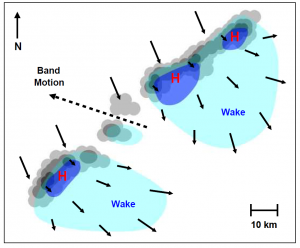 Surface cold pools are areas of evaporatively cooled downdraft air that have spread out beneath a precipitating cloud. In midlatitudes, cold pools are common, play an integral role in the development of new convective cells along their leading edge, and are known to be the primary mechanism for the sustenance of multicell thunderstorms and convective lines. In tropical cyclones (TCs), cold pools are believed to be less common due to the relative lack of dry air. When observed, they are often associated with outer rainbands or bands adjacent to inward-spiraling dry air intrusions. Moreover, prominent cold pools can have a significant effect on the distribution of inner-core convective activity and overall storm intensity.
Surface cold pools are areas of evaporatively cooled downdraft air that have spread out beneath a precipitating cloud. In midlatitudes, cold pools are common, play an integral role in the development of new convective cells along their leading edge, and are known to be the primary mechanism for the sustenance of multicell thunderstorms and convective lines. In tropical cyclones (TCs), cold pools are believed to be less common due to the relative lack of dry air. When observed, they are often associated with outer rainbands or bands adjacent to inward-spiraling dry air intrusions. Moreover, prominent cold pools can have a significant effect on the distribution of inner-core convective activity and overall storm intensity.
Past research efforts were directed toward a better understanding of the frequency and magnitude convective downdrafts and cold pools associated with tropical cyclone rainbands. Such events may promote the baroclinic enhancement of miniature supercells and the tornadoes they often spawn during a landfalling tropical cyclone. Our primary approach was through extensive analysis of either (1) coastal radar, surface, and rawinsonde observations (for landfalling rainbands) or (2) airborne radar with buoy and dropsonde observations (for offshore rainbands).
This research was primarily funded through grants from UNC Charlotte with additional support from the Renaissance Computing Institute, the communities of Brunswick County (NC), and the NOAA Hurricane Research Division.
Relevant Publications:
Eastin, M.D., T.L. Gardner, M.C. Link, and K.C. Smith, 2012: Surface cold pools in the outer rainbands of Tropical Storm Hanna (2008) near landfall. Monthly Weather Review, 140, 471-491.